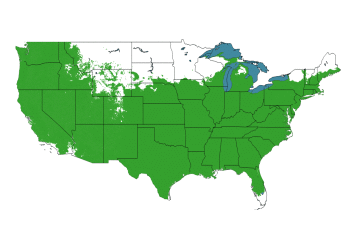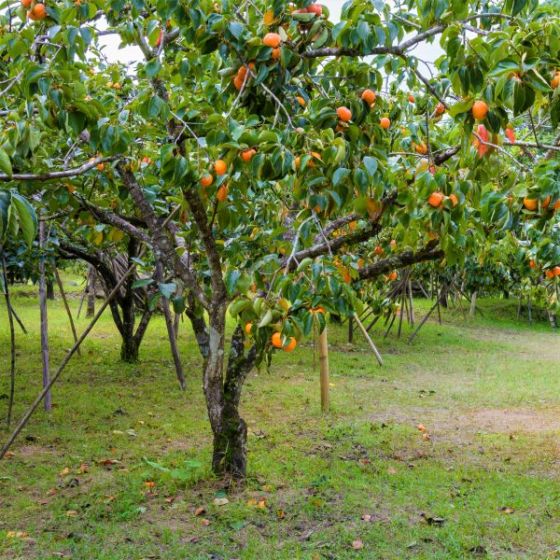✖
American Persimmon
Diospyros virginiana
Out of stock
SKU
PFY-494
Four Season American Persimmon
- Sweet, Delicious Fruit
- Four Season Tree
- Native Beauty
- Fall Color
- Ornamental Bark
People across America are searching for native trees that bear healthy fruit and bring an exotic flair to their yards. Enjoyed for many thousands of years by the Native Americans for fresh eating, as well as a cooked and dried food staple, the American Persimmon (Diospyros virginiana) is coming back into vogue.
The Persimmon offers ornamental bark, wonderfully robust foliage, tremendous fall color and delicious edible fruit on an easy-care plant. What's not to love?
People are really starting to value our native trees and discovering the thrill of growing their own food. What a joy to have a plant that gives you food!
LetsPlantify.com is seeing a huge trend in home gardening called 'edible landscaping'. It's the idea of mixing fruit and vegetable plants in with your ornamental perennials and flowers.
Cousins to the Asian Persimmon, American Persimmon trees produce round fruit that starts out green, then turns to orange, deep red or even soft purple. Ripe fruit has a uniquely sweet but nutty flavor. With a soft texture, American Persimmon fruit has been baked into puddings and pies for many centuries.
American Persimmon trees look great all year.
From the brilliant bright green leaves of spring to the wonderful mixed red and orange fall colors, the American Persimmon has wonderful display value in a naturalized landscape. When they've gone dormant even the bark is pretty! The bark is thick dark gray and corky, broken into even rectangular blocks. You'll love the very distinctive look in winter.
Don't miss this chance to own a piece of American history.
How to Use American Persimmon in the Landscape
Native Americans and the first European settlers immediately saw the value in this incredibly versatile plant. Few other plants offered so much as the American Persimmon. From food to medicine to tool making and dyes, the American Persimmon could provide like no other native plant.
Today, it's value is both edible and ornamental. We no longer make tools or golf club heads from the wood, nor dyes from the bark or a coffee-like drink from the dried ground seeds. (Although, heck, you could try it!)
In the wild, mature trees typically grow as a thicket. Try a natural look by planting several trees together. This is an outstanding plant to adorn the back of the garden or to help anchor a border in the landscape.
They love full sun and look great in a mixed border. Try one with an underplanting of Daylilies and Catmint.
One thing is for sure. You'll ALWAYS have something to talk about with your guests who are new to your garden when you plant a heritage tree like this one.
#ProPlantTips for Care
American Persimmons are widely adaptable and grow in a wide range of soil types. They prefer moist, sandy locations with well-drained soil. They are drought tolerant in dry locations once established.
American Persimmon does require cross pollination. Although some flowers may be perfect, most plants have separate male and female trees (dioecious). We suggest you plant at least two (or more) to increase chances to pollinate.
Unripe fruit is astringent and is best after it's soft and fully ripe in fall. You can also pick unripe fruit after it takes on its fall color. You'll then let it fully ripen to soft for best flavor.
Persimmon fruits are low in calories and fat, but high in fiber, vitamins and other nutrients. The fruit is commonly eaten fresh off the tree where it will hang until after the leaves drop. The fruit is also used in making breads and puddings as well as ice cream, syrups and Persimmon pies.
These plants have no serious insect or disease problems. The plant requires very little maintenance.
Persimmon is a lovely ornamental that also gives us outstanding fall fruit. Quite simply, this tree is an attractive option with many benefits.
Don't miss having one of these in your garden this year!
| Botanical Name | Diospyros virginiana |
|---|---|
| Mature Height | 30 - 50 feet |
| Mature Spread | 20 - 35 feet |
| Soil Type | Well-Drained |
| Moisture | Moderate, Low |
| Sun Exposure | Full Sun |
| Growth Rate | Medium |
| Bloom Period | Late Spring |
| Flower Color | White |
| Foliage Color | Green |
| Fall Color | Orange, Red |
| Fruiting Time | Late Season |
| Pollinator Required | Yes |
| Pollinator Friendly | Yes |
| Growing Zone Range | 5-9 |

Write Your Own Review

